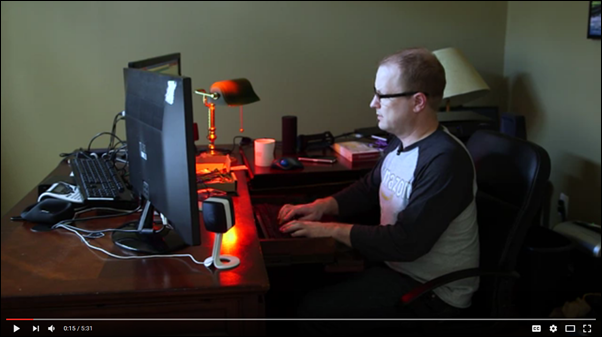Category: Amazon Lex
Announcing the AWS Chatbot Challenge – Create Conversational, Intelligent Chatbots using Amazon Lex and AWS Lambda
If you have been checking out the launches and announcements from the AWS 2017 San Francisco Summit, you may be aware that the Amazon Lex service is now Generally Available, and you can use the service today. Amazon Lex is a fully managed AI service that enables developers to build conversational interfaces into any application using voice and text. Lex uses the same deep learning technologies of Amazon Alexa-powered devices like Amazon Echo. With the release of Amazon Lex, developers can build highly engaging lifelike user experiences and natural language interactions within their own applications. Amazon Lex supports Slack, Facebook Messenger, and Twilio SMS enabling you to easily publish your voice or text chatbots using these popular chat services. There is no better time to try out the Amazon Lex service to add the gift of gab to your applications, and now you have a great reason to get started.
May I have a Drumroll please?
I am thrilled to announce the AWS Chatbot Challenge! The AWS Chatbot Challenge is your opportunity to build a unique chatbot that helps solves a problem or adds value for prospective users. The AWS Chatbot Challenge is brought to you by Amazon Web Services in partnership with Slack.
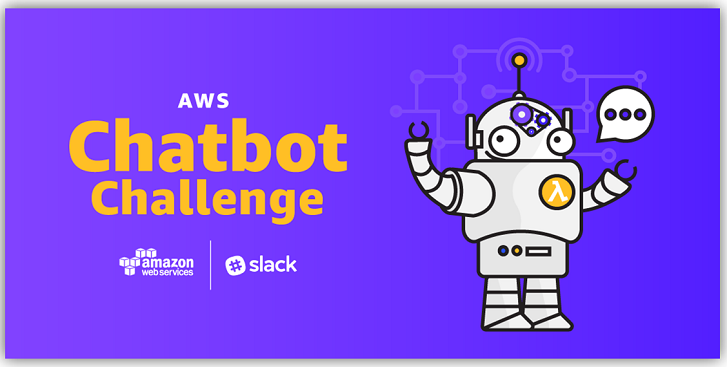
The Challenge
Your mission, if you choose to accept it, is to build a conversational, natural language chatbot using Amazon Lex and leverage Lex’s integration with AWS Lambda to execute logic or data processing on the backend. Your submission can be a new or existing bot, however, if your bot is an existing one it must have been updated to use Amazon Lex and AWS Lambda within the challenge submission period.
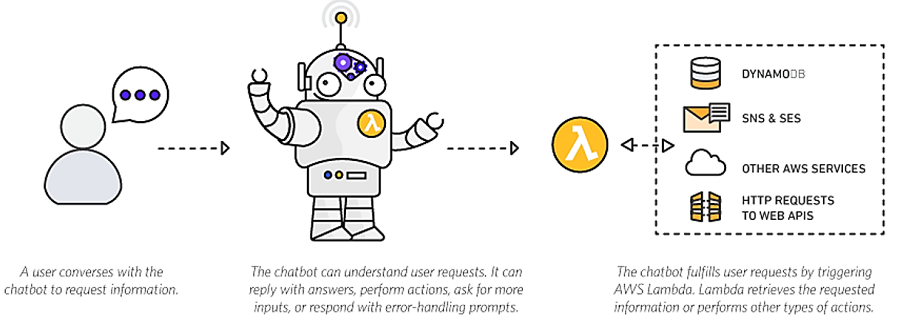
You are only limited by your own imagination when building your solution. Therefore, I will share some recommendations to help you to get your creative juices flowing when creating or deploying your bot. Some suggestions that can help you make your chatbot more distinctive are:
- Deploy your bot to Slack, Facebook Messenger, or Twilio SMS
- Take advantage of other AWS services when building your bot solution.
- Incorporate Text-To-speech capabilities using a service like Amazon Polly
- Utilize other third-party APIs, SDKs, and services
- Leverage Amazon Lex pre-built enterprise connectors and add services like Salesforce, HubSpot, Marketo, Microsoft Dynamics, Zendesk, and QuickBooks as data sources.
There are cost effective ways to build your bot using AWS Lambda. Lambda includes a free tier of one million requests and 400,000 GB-seconds of compute time per month. This free, per month usage, is for all customers and does not expire at the end of the 12 month Free Tier Term. Furthermore, new Amazon Lex customers can process up to 10,000 text requests and 5,000 speech requests per month free during the first year. You can find details here.
Remember, the AWS Free Tier includes services with a free tier available for 12 months following your AWS sign-up date, as well as additional service offers that do not automatically expire at the end of your 12 month term. You can review the details about the AWS Free Tier and related services by going to the AWS Free Tier Details page.

Can We Talk – How It Works
The AWS Chatbot Challenge is open to individuals, and teams of individuals, who have reached the age of majority in their eligible area of residence at the time of competition entry. Organizations that employ 50 or fewer people are also eligible to compete as long at the time of entry they are duly organized or incorporated and validly exist in an eligible area. Large organizations-employing more than 50-in eligible areas can participate but will only be eligible for a non-cash recognition prize.
Chatbot Submissions are judged using the following criteria:
- Customer Value: The problem or painpoint the bot solves and the extent it adds value for users
- Bot Quality: The unique way the bot solves users’ problems, and the originality, creativity, and differentiation of the bot solution
- Bot Implementation: Determination of how well the bot was built and executed by the developer. Also, consideration of bot functionality such as if the bot functions as intended and recognizes and responds to most common phrases asked of it
Prizes
The AWS Chatbot Challenge is awarding prizes for your hard work!
First Prize
- $5,000 USD
- $2,500 AWS Credits
- Two (2) tickets to AWS re:Invent
- 30 minute virtual meeting with the Amazon Lex team
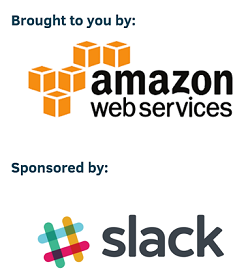
- Winning submission featured on the AWS AI blog
- Cool swag
Second Prize
- $3,000 USD
- $1,500 AWS Credits
- One (1) ticket to AWS re:Invent
- 30 minute virtual meeting with the Amazon Lex team
- Winning submission featured on the AWS AI blog
- Cool swag
Third Prize
- $2,000 USD
- $1,000 AWS Credits
- 30 minute virtual meeting with the Amazon Lex team
- Winning submission featured on the AWS AI blog
- Cool swag
Challenge Timeline
- Submissions Start: April 19, 2017 at 12:00pm PDT
- Submissions End: July 18, 2017 at 5:00pm PDT
- Winners Announced: August 11, 2017 at 9:00am PDT
Up to the Challenge – Get Started
Are ready to get started on your chatbot and dive into the challenge? Here is how to get started:
Review the details on the challenge rules and eligibility
- Register for the AWS Chatbot Challenge
- Join the AWS Chatbot Slack Channel
- Create an account on AWS.
- Visit the Resources page for links to documentation and resources.
- Shoot your demo video that demonstrates your bot in action. Prepare a written summary of your bot and what it does.
- Provide a way to access your bot for judging and testing by including a link to your GitHub repo hosting the bot code and all deployment files and testing instructions needed for testing your bot.
- Submit your bot on AWSChatbot2017.Devpost.com before July 18, 2017 at 5 pm ET and share access to your bot, its Github repo and its deployment files.
Summary
With Amazon Lex you can build conversation into web and mobile applications, as well as use it to build chatbots that control IoT devices, provide customer support, give transaction updates or perform operations for DevOps workloads (ChatOps). Amazon Lex provides built-in integration with AWS Lambda, AWS Mobile Hub, and Amazon CloudWatch and allows for easy integrate with other AWS services so you can use the AWS platform for to build security, monitoring, user authentication, business logic, and storage into your chatbot or application. You can make additional enhancements to your voice or text chatbot by taking advantage of Amazon Lex’s support of chat services like Slack, Facebook Messenger, and Twilio SMS.
Dive into building chatbots and conversational interfaces with Amazon Lex and AWS Lambda with the AWS Chatbot Challenge for a chance to win some cool prizes. Some recent resources and online tech talks about creating bots with Amazon Lex and AWS Lambda that may help you in your bot building journey are:
- Announcing Amazon Lex – January 2017 AWS Online Tech Talks
- Introducing Amazon Lex: Service for Building Voice/Text Chatbots – March 2017 AWS Online Tech Talks
- Amazon Lex Documentation: Amazon Lex and AWS Lambda Blueprints
- AWS AI Blog: Building Better Bots Using Amazon Lex (Part 1)
- AWS AI Blog: Building Better Bots Using Amazon Lex (Part 2)
- Slack Blog: Your app can now use the same deep-learning technology inside Amazon’s Alexa: Announcing Amazon Lex support for Slack
- In Europe? Join the Slack Dev Roadshow to learn how to build chatbots in the workshops hosted by the Slack platform team
If you have questions about the AWS Chatbot Challenge you can email aws-chatbot-challenge-2017@amazon.com or post a question to the Discussion Board.
Good Luck and Happy Coding.
– Tara
Amazon Lex – Now Generally Available
During AWS re:Invent I showed you how you could use Amazon Lex to build conversational voice & text interfaces. At that time we launched Amazon Lex in preview form and invited developers to sign up for access. Powered by the same deep learning technologies that drive Amazon Alexa, Amazon Lex allows you to build web & mobile applications that support engaging, lifelike interactions.
Today I am happy to announce that we are making Amazon Lex generally available, and that you can start using it today! Here are some of the features that we added during the preview:
Slack Integration – You can now create Amazon Lex bots that respond to messages and events sent to a Slack channel. Click on the Channels tab of your bot, select Slack, and fill in the form to get a callback URL for use with Slack:

Follow the tutorial (Integrating an Amazon Lex Bot with Slack) to see how to do this yourself.
Twilio Integration – You can now create Amazon Lex bots that respond to SMS messages sent to a Twilio SMS number. Again, you simply click on Channels, select Twilio, and fill in the form:

To learn more, read Integrating an Amazon Lex Bot with Twilio SMS.
SDK Support – You can now use the AWS SDKs to build iOS, Android, Java, JavaScript, Python, .Net, Ruby, PHP, Go, and C++ bots that span mobile, web, desktop, and IoT platforms and interact using either text or speech. The SDKs also support the build process for bots; you can programmatically add sample utterances, create slots, add slot values, and so forth. You can also manage the entire build, test, and deployment process programmatically.
Voice Input on Test Console – The Amazon Lex test console now supports voice input when used on the Chrome browser. Simply click on the microphone:
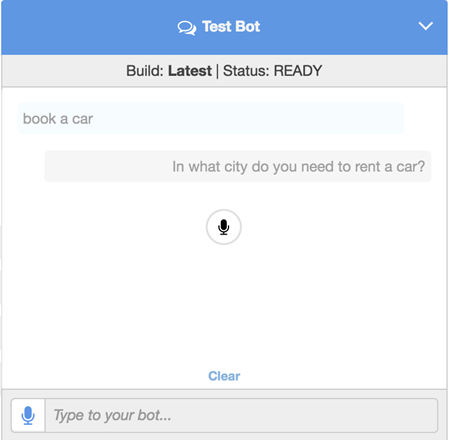
Utterance Monitoring – Amazon Lex now records utterances that were not recognized by your bot, otherwise known as missed utterances. You can review the list and add the relevant ones to your bot:

You can also watch the following CloudWatch metrics to get a better sense of how your users are interacting with your bot. Over time, as you add additional utterances and improve your bot in other ways, the metrics should be on the decline.
- Text Missed Utterances (PostText)
- Text Missed Utterances (PostContent)
- Speech Missed Utterances
Easy Association of Slots with Utterances – You can now highlight text in the sample utterances in order to identify slots and add values to slot types:
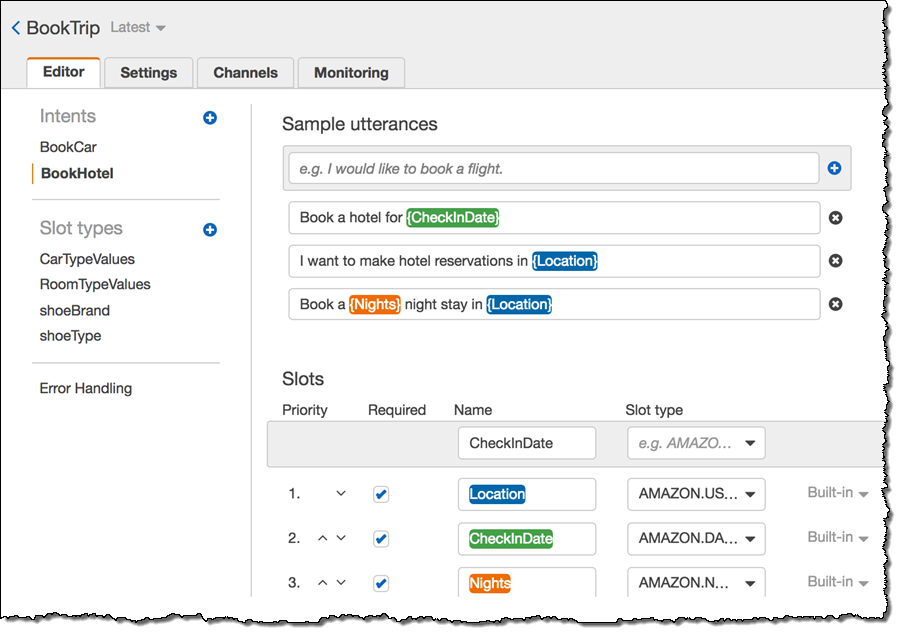
Improved IAM Support – Amazon Lex permissions are now configured automatically from the console; you can now create bots without having to create your own policies.
Preview Response Cards – You can now view a preview of the response cards in the console:

To learn more, read about Using a Response Card.
Go For It
Pricing is based on the number of text and voice responses processed by your application; see the Amazon Lex Pricing page for more info.
I am really looking forward to seeing some awesome bots in action! Build something cool and let me know what you come up with.
— Jeff;
Pollexy – Building a Special Needs Voice Assistant with Amazon Polly and Raspberry Pi
April is Autism Awareness month and about 1 in 68 children in the U.S. have been identified with autism spectrum disorder (ASD) (CDC 2014). In this post from Troy Larson, a Sr. Devops Cloud Architect here at AWS, you get an introduction to a project he has been working on to help his son Calvin.
I have been asked how the minds at AWS come up with so many different ideas. Sometimes they come from a deeply personal place, where someone sees a way to help others. Pollexy is an amazing example of just that. Read about Pollexy and then watch the video here.
-Ana
Background
As a computer programming parent of a 16-year old non-verbal teenage boy with autism, I have been constantly searching over the years to find ways to use technology to make our lives together safer, happier and more comfortable. At the core of this challenge is the most basic of all human interaction—communication. While Calvin is able to respond to verbal instruction, he is not able to speak responsively. In his entire life, we’ve never had a conversation. He is able to be left alone in his room to play, but most every task or set of tasks requires a human to verbally prompt him along the way. Having other children and responsibilities in the home, at times the intensity of supervision can be negatively impactful on the home dynamic.
Genesis
When I saw the announcement of Amazon Polly and Amazon Lex at re:Invent last year, I immediately started churning on how we could leverage these technologies to assist Calvin. He responds well to human verbal prompts, but would he understand a digital voice? So one Saturday, I setup a Raspberry Pi in his room and closed his door and crouched around the corner with other family members so Calvin couldn’t see us. I connected to the Raspberry Pi and instructed Polly to speak in Joanna’s familiar pacific tone, “Calvin, it’s time to take a potty break. Go out of your bedroom and go to the bathroom.” In a few seconds, we heard his doorknob turn and I poked my head out of my hiding place. Calvin passed by, looking at me quizzically, then went into the bathroom as Joanna had instructed. We all looked at each other in amazement—he had listened and responded perfectly to the completely invisible voice of someone he’d never heard before. After discussing some ideas around this with co-workers, a colleague suggested I enter the IoT and AI Science Fair at our annual AWS Sales Kick-Off meeting. Less than two months after the Polly and Lex announcement and 3500 lines of code later, Pollexy—along with Calvin–debuted at the Science Fair.
Overview
Pollexy (“Polly” + “Lex”) is a Raspberry Pi and mobile-based special needs verbal assistant that lets caretakers schedule audio task prompts and messages both on a recurring schedule and/or on-demand. Caretakers can schedule regular medicine reminder messages or hourly bathroom break messages, for example, and at the same time use their Amazon Echo and mobile device to request a specific message be played immediately. Caretakers can even set it up so that the person needs to confirm that they’ve heard the message. For example, my son won’t pay attention to Pollexy unless Pollexy first asks him to “Push the blue button.” Pollexy will wait until he has pushed the button and then speak the actual message. Other people may be able to respond verbally using Lex, or not require a confirmation at all. Pollexy can be tailored to what works best.
And then most importantly—and most challenging—in a large house, how do we make sure the person is in the room where we play the message? What if we have a special needs adult living in an in-law suite? Are they in the living room or the kitchen? And what about multiple people? What if we have multiple people in different areas of the house, each of whom has a message? Let’s explore the basic elements and tie the pieces together.
Basic Elements of Pollexy
In the spirit of Amazon’s Leadership Principle “Invent and Simplify,” we want to minimize the complexity of the Pollexy architecture. We can break Pollexy down into three types of objects and three components, all of which work together in a way that’s easily explainable.

Object #1: Person
Pollexy can support any number of people. A person is a uniquely identifiable name. We can set basic preferences such as “requires confirmation” and most importantly, we can define a location schedule. This means that we can create an Outlook-like schedule that sets preferences where someone should be in the house.
Object #2: Location
A location is simply a uniquely identifiable location where a device is physically sitting. Based on the user’s location schedule, Pollexy will know which device to contact first, second, third, etc. We can also “mute” devices if needed (naptime, etc.)
Object #3: Message
Obviously, this is the actual message we want to play. Attached to each message is a person and a recurring schedule (only if it’s not a one-time message). We don’t store location with the message, because Pollexy figures out the person’s location when the message is ready to be delivered.
Component #1: Scheduler
Every message needs to be scheduled. This is a command-line tool where you basically say Tell “Calvin” that “you need to brush your teeth” every night at 8 p.m. This message is then stored in DynamoDB, waiting to be picked up by the queueing Lambda function.
Component #2: Queueing Engine
Every minute, a Lambda runs and checks the scheduler to see if there is a message or messages ready to be delivered. If a message is ready, it looks up the person’s location schedule and figures out where they are and then pushes the message or messages into an SQS queue for that location.
Component #3: Speaker Engine
Every minute on the Raspberry Pi device, the speaker engine spins up and checks the SQS for its location. If there are messages, then the speaker engine looks at the user’s preferences and initiates communication to convey the message. If the person doesn’t respond, the speaker engine will check if the person has a secondary location in their schedule and drop the message in the SQS Queue for that location. In the end, a message will either be delivered or eventually just timeout (if someone is out of the house for the day).
Respect and Freedom are the Keys
We often take our personal privacy and respect for granted, so imagine even for a special needs person, the lack of privacy and freedom around having a person constantly in your presence. This is exaggerated for those in the autism spectrum where invasion of personal space can escalate a sense of invasion, turning into anger and frustration. Pollexy becomes their own personal, gentle and never-flustered friend to coach to them along the way, giving them confidence, respect and the sense of privacy and freedom we all want to enjoy.
-Troy Larson
Amazon Lex – Build Conversational Voice & Text Interfaces
While computers that talk are great, computers that listen and respond are even better! If you have used an Amazon Echo, you know how simple, useful, and powerful the Alexa-powered interaction model can be.
Today we are making the same deep learning technologies (ASR – Automatic Speech Recognition NLU – Natural Language Understanding) that power Amazon Alexa available to you for use in your own conversational applications. You can use Amazon Lex to build chatbots and other types of web & mobile applications that support engaging, lifelike interactions. Your bots can provide information, power your application, streamline work activities, or provide a control mechanism for robots, drones, and toys.
Amazon Lex is designed to let you get going quickly. You start out by designing your conversation in the Lex Console, providing Lex with some sample phrases that are used to build a natural language model. Then you publish your Amazon Lex bot and let it process text or voice conversations with your users. Amazon Lex is a fully-managed service so you don’t need to spend time setting up, managing, or scaling any infrastructure.
Your chatbot can connect with Facebook Messenger today; Slack and Twilio integration is in the works as well. On the AWS side, it works with AWS Lambda, AWS Mobile Hub, and Amazon CloudWatch. Your code can make use of Amazon DynamoDB, Amazon Cognito, and other services.
Amazon Lex lets you use AWS Lambda functions to implement the business logic for your bot, including connections to your enterprise applications and data. In conjunction with the newly announced SaaS integration for AWS Mobile Hub, you can build enterprise productivity bots that provide conversational interfaces to the accounts, contacts, leads, and other enterprise data stored in the SaaS applications that you are already using.
Putting it all together, you now have access to all of the moving parts needed to build fully integrated solutions that start at the mobile app and go all the way to the fulfillment logic.
Amazon Lex Concepts
Let’s take a quick look at the principal Amazon Lex concepts:
Bot – A bot contains all of the components of a conversation.
Intent – An intent represents a goal that the bot’s user wants to achieve (buying a plane ticket, scheduling an appointment, or getting a weather forecast, and so forth).
Utterance – An utterance is a spoken or typed phrase that invokes an intent. “I want to book a hotel” or “I want to order flowers” are two simple utterances.
Slots – Each slot is a piece of data that the user must supply in order to fulfill the intent. Slots are typed; a travel bot could have slots for cities, states or airports.
Prompt – A prompt is a question that asks the user to supply some data (for a slot) that is needed to fulfill an intent.
Fulfillment – Fulfillment is the business logic that carries our the user’s intent. Lex supports the use of Lambda functions for fulfillment.
Bots, intents, and slots are versioned so that you can draw clear lines between development, testing, staging, and production, in a multi-developer environment. You can create multiple aliases for each of your bots and maps them to specific versions of the components.
Building a Bot
You can define your Lex bot and set up all of these components from the Lex Console. You can start with one of the samples or you can create a custom bot:

You define your utterances and their slots on the next page:
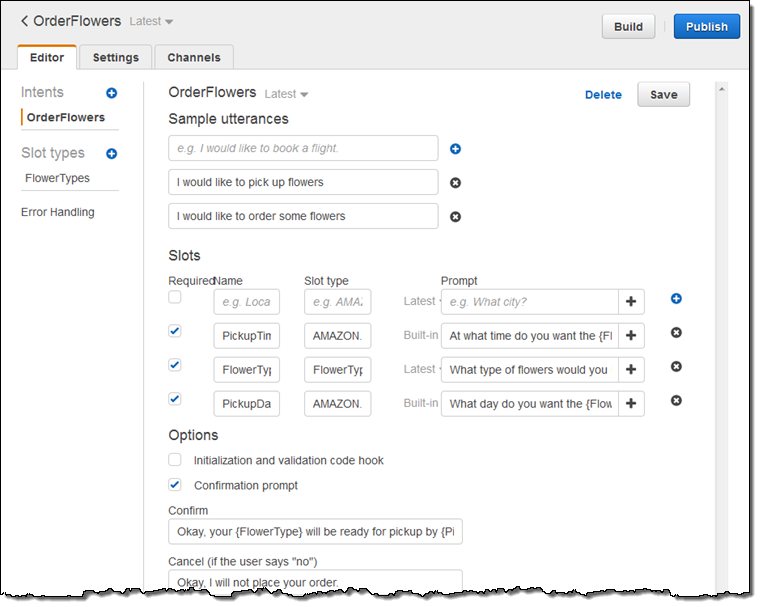
And customize your bot using the settings:
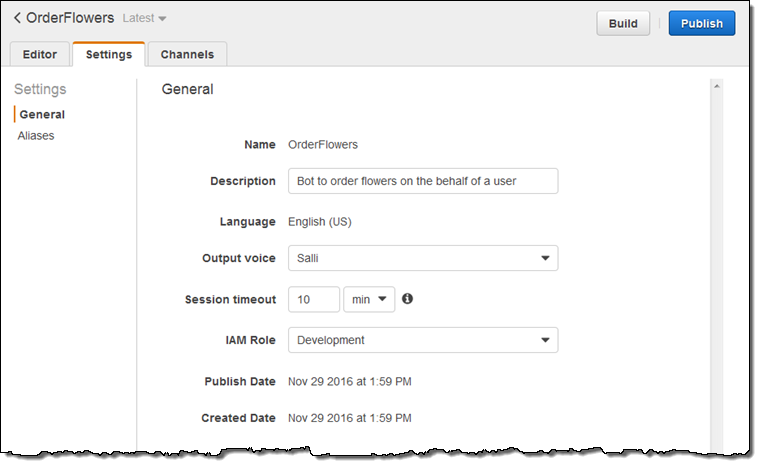
You can test your bot interactively and refine it until it works as desired:
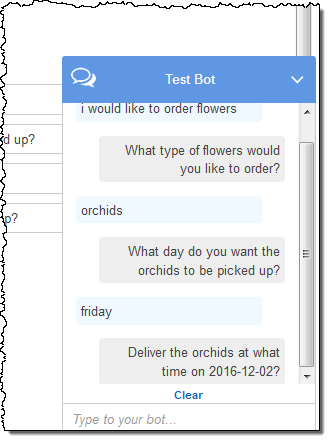
Then you can generate a callback URL for use with Facebook (and others on the way):
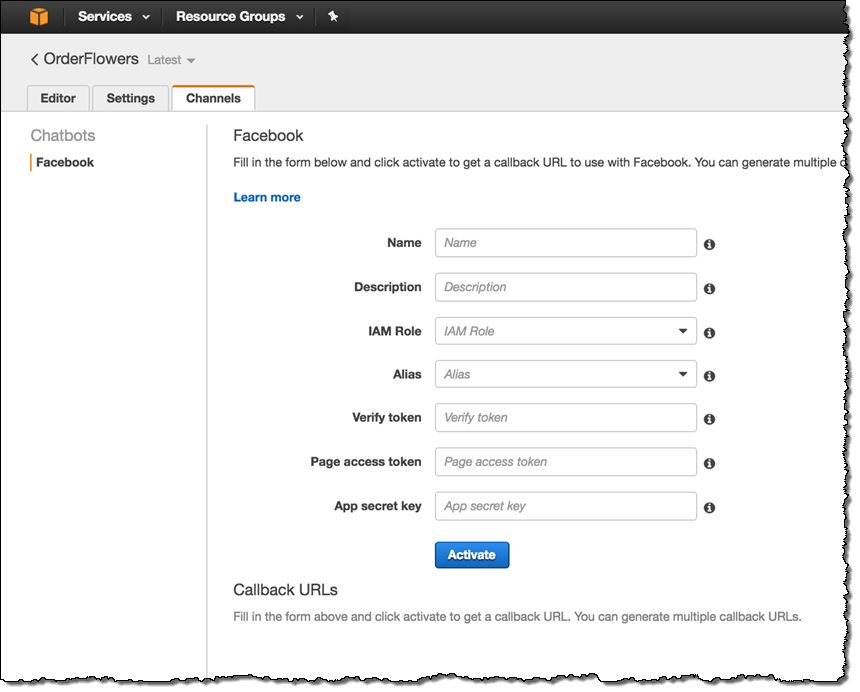
I’ll share more details as soon as the re:Invent rush is over and I have time to really dig in.
Pricing and Availability
Amazon Lex is available in preview form in the US East (Northern Virginia) Region and you can start building conversational applications today!
After you sign up, you can make 10,000 text requests and 5,000 speech requests each month at no charge for the first year. After that you will pay $4.00 for each 1,000 speech requests and $0.75 for every 1,000 text requests.
— Jeff;
Update! We have a webinar about Lex coming up on January 17th. You can sign up for it here.
